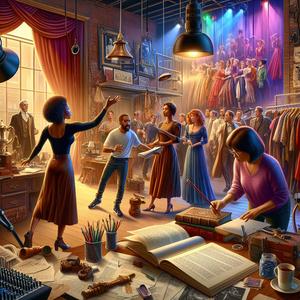
Exploring 20 Dynamic Career Paths for Animation Graduates: Insights, Requirements, and Opportunities
Animation stands at the crossroads of creativity and technology, evolving continuously to meet the demands of various industries. Graduates armed with an animation degree can navigate a diverse array of career paths, including roles like animators, storyboard artists, and visual effects specialists. This article provides a comprehensive look into the exciting job opportunities that await animation graduates, highlighting both traditional and emerging sectors that increasingly rely on animated visuals to tell compelling stories.
Job Summaries:
Animator:
- Animators create captivating characters and scenes using advanced software for 2D and 3D animations.
- A bachelor’s degree in animation or a similar field is typically required, alongside proficiency in tools such as Maya or After Effects.
- Animators are essential to visual storytelling across film, television, and gaming.
Storyboard Artist:
- Storyboard artists bring scripts to life through a series of illustrations that depict scene transitions.
- A strong foundation in drawing and an understanding of cinematic language are crucial, often supported by a degree in fine arts or animation.
- This role is vital during the pre-production phase.
3D Modeler:
- 3D modelers craft three-dimensional objects for various media, utilizing specialized software.
- A degree in animation or computer graphics and expertise in platforms like Blender or ZBrush are typically required.
- This role is increasingly sought-after for its ability to transform visual ideas into tangible designs.
Motion Graphics Designer:
- Motion graphics designers create animated graphics and special effects.
- Primarily for video content in advertising and film.
- A bachelor’s degree in graphic design or animation is generally necessary.
- Proficiency in After Effects is generally necessary.
- This role enhances narratives through dynamic visuals.
Visual Effects (VFX) Artist:
- VFX artists integrate CGI with live-action footage, producing stunning visual effects.
- A degree in animation or visual effects is often required.
- Expertise in software like Nuke or Houdini is often required.
- They play a key role in the filmmaking process.
Character Designer:
- Character designers develop the look and personality of animated figures.
- They create detailed character sheets.
- A solid design background is essential for this role.
- Typically, this background is fostered through a degree in animation or fine arts.
- A solid design helps establish emotional connections with audiences.
Art Director:
- Art directors oversee the visual components of animation projects.
- They ensure that the artistic vision aligns with the narrative.
- A degree in art, design, or animation is usually required.
- Significant industry experience is also necessary.
- This position greatly influences audience perception.
Video Game Designer:
- Video game designers conceptualize and develop gameplay mechanics, characters, and storylines.
- A degree in game design or a related field is typically necessary.
- This career is particularly appealing in the rapidly expanding gaming industry.
Graphic Designer:
- Graphic designers produce visual content across various media, including websites and promotional materials.
- A bachelor’s degree in graphic design or a related area is typically needed.
- A comprehensive portfolio demonstrating design prowess is required.
Concept Artist:
- Concept artists generate initial visual representations of characters and environments.
- They often rely on a degree in fine arts or animation.
- Strong drawing skills are essential for setting the visual tone of a project.
Production Designer:
- Production designers create the overall visual concept for animation and film projects.
- They collaborate closely with directors.
- A background in production design or fine arts is generally required.
Lighting Artist:
- Lighting artists enhance animated scenes through strategic lighting effects, influencing mood and atmosphere.
- A background in fine arts or animation, coupled with experience in lighting software, is often needed.
Background Designer:
- Background designers craft the environments for animated work, ensuring harmony with character designs and the story.
- A degree in fine arts or animation, along with illustration skills, is typically necessary.
Character Technical Director:
- Character technical directors (TDs) focus on rigging characters for realistic movement.
- A background in animation or computer graphics, alongside technical skills, is essential in this critical role.
Compositing Artist:
- Compositing artists merge various visual elements to create cohesive final images in animated projects.
- A degree in animation or visual effects, along with proficiency in compositing software, is often required.
Game Artist:
- Game artists design visual elements for video games, including characters and environments.
- A degree in game design or animation is typically necessary, supported by a strong artistic portfolio.
Stop-Motion Animator:
- Stop-motion animators produce animations using physical objects.
- Capturing frames to create motion.
- A background in fine arts or animation is generally needed for this unique role.
Forensic Animator:
- Forensic animators create visual representations for legal cases.
- They collaborate with law enforcement.
- A degree in animation or criminal justice is often required.
- Technical skills in 3D modeling are often required.
Mathematical Modeler:
- Mathematical modelers employ mathematical techniques to create simulations for animations.
- A degree in mathematics or computer science is typically necessary.
- Strong analytical capabilities are typically required.
Educational Animator:
- Educational animators develop animated content for educational purposes.
- Animations effectively convey learning objectives.
- A degree in animation or education is usually required.
This exploration of diverse animation career paths equips aspiring professionals with a clearer understanding of their options and the necessary qualifications for success in this dynamic industry. Each role contributes uniquely to the animation landscape, allowing graduates to carve out a niche that resonates with their individual skills and passions. As the demand for animation continues to rise across various sectors, opportunities for career advancement remain promising for those committed to ongoing education and professional growth.
Explore More Jobs
